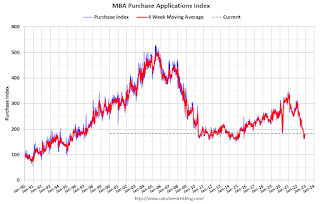by Calculated Risk on 12/23/2022 10:43:00 AM
Friday, December 23, 2022
New Home Sales Increased in November; Previous 3 Months Revised Down Sharply
Today, in the Calculated Risk Real Estate Newsletter: New Home Sales Increased in November; Previous 3 Months Revised Down Sharply
Brief excerpt:
The next graph shows the months of supply by stage of construction. “Months of supply” is inventory at each stage, divided by the sales rate.You can subscribe at https://calculatedrisk.substack.com/.
There are 1.2 months of completed supply (red line). This is getting close to the normal level.
The inventory of new homes under construction is at 5.5 months (blue line). This elevated level of homes under construction is due to supply chain constraints.
And about 2.0 months of potential inventory have not been started (grey line) - about double the normal level. Homebuilders are probably waiting to start some homes until they have a firmer grasp on prices and demand.
...
As I discussed two months ago, the Census Bureau overestimates sales, and underestimates inventory when cancellation rates are rising, see: New Home Sales and Cancellations: Net vs Gross Sales. So, take the headline sales number with a large grain of salt - the actual negative impact on the homebuilders is far greater than the headline number suggests!
There are a large number of homes under construction, and this suggests we will see a sharp increase in completed inventory over the next several months - and that will put pressure on new home prices.
New Home Sales Increase to 640,000 Annual Rate in November
by Calculated Risk on 12/23/2022 10:08:00 AM
The Census Bureau reports New Home Sales in November were at a seasonally adjusted annual rate (SAAR) of 640 thousand.
The previous three months were revised down sharply.
Sales of new single‐family houses in November 2022 were at a seasonally adjusted annual rate of 640,000, according to estimates released jointly today by the U.S. Census Bureau and the Department of Housing and Urban Development. This is 5.8 percent above the revised October rate of 605,000, but is 15.3 percent below the November 2021 estimate of 756,000.
emphasis added
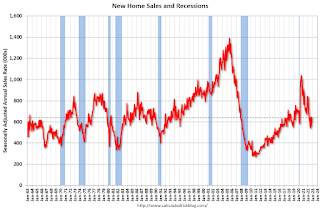 Click on graph for larger image.
Click on graph for larger image.The first graph shows New Home Sales vs. recessions since 1963. The dashed line is the current sales rate.
New home sales are below pre-pandemic levels.
The second graph shows New Home Months of Supply.
 The months of supply decreased in November to 8.6 months from 9.3 months in October.
The months of supply decreased in November to 8.6 months from 9.3 months in October. The all-time record high was 12.1 months of supply in January 2009. The all-time record low was 3.5 months, most recently in October 2020.
This is well above the top of the normal range (about 4 to 6 months of supply is normal).
"The seasonally‐adjusted estimate of new houses for sale at the end of November was 461,000. This represents a supply of 8.6 months at the current sales rate."
 The last graph shows sales NSA (monthly sales, not seasonally adjusted annual rate).
The last graph shows sales NSA (monthly sales, not seasonally adjusted annual rate).In November 2022 (red column), 46 thousand new homes were sold (NSA). Last year, 54 thousand homes were sold in November.
The all-time high for November was 86 thousand in 2005, and the all-time low for November was 20 thousand in 2010.
This was above expectations, however sales in the three previous months were revised down. I'll have more later today.
Personal Income increased 0.4% in November; Spending increased 0.1%
by Calculated Risk on 12/23/2022 08:36:00 AM
The BEA released the Personal Income and Outlays report for November:
Personal income increased $80.1 billion (0.4 percent) in November, according to estimates released today by the Bureau of Economic Analysis. Disposable personal income (DPI) increased $68.6 billion (0.4 percent) and personal consumption expenditures (PCE) increased $19.8 billion (0.1 percent).The November PCE price index increased 5.5 percent year-over-year (YoY), down from 6.1 percent YoY in October.
The PCE price index increased 0.1 percent. Excluding food and energy, the PCE price index increased 0.2 percent. Real DPI increased 0.3 percent in November and real PCE increased less than 0.1 percent; goods decreased 0.6 percent and services increased 0.3 percent.
emphasis added
The following graph shows real Personal Consumption Expenditures (PCE) through November 2022 (2012 dollars). Note that the y-axis doesn't start at zero to better show the change.
 Click on graph for larger image.
Click on graph for larger image.The dashed red lines are the quarterly levels for real PCE.
Personal income was above expectations, and the increase in PCE was below expectations.
Using the two-month method to estimate Q4 real PCE growth, real PCE was increasing at a 4.0% annual rate in Q3 2022. (Using the mid-month method, real PCE was increasing at 3.0%)
Thursday, December 22, 2022
Friday: Durable Goods, Personal Income & Outlays, New Home Sales
by Calculated Risk on 12/22/2022 08:25:00 PM
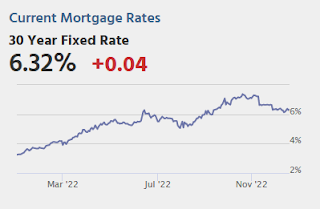
Friday:
• At 8:30 AM ET, Durable Goods Orders for November. The consensus is for a 0.1% increase..
• Also, at 8:30 AM: Personal Income and Outlays for November. The consensus is for a 0.2% increase in personal income, and for a 0.2% increase in personal spending. And for a 0.3% increase in the PCE prices index, and the Core PCE price index to increase 0.2%. PCE prices are expected to be up 5.7% YoY, and core PCE prices up 4.7% YoY.
• At 10:00 AM: New Home Sales for November from the Census Bureau. The consensus is for 595 thousand SAAR, down from 632 thousand in October.
• Also, at 10:00 AM: University of Michigan's Consumer sentiment index (Final for December).
• Also, at 10:00 AM: State Employment and Unemployment (Monthly) for November 2022
Freddie Mac: Mortgage Serious Delinquency Rate unchanged in November
by Calculated Risk on 12/22/2022 04:48:00 PM
Freddie Mac reported that the Single-Family serious delinquency rate in November was 0.66%, unchanged from 0.66% October. Freddie's rate is down year-over-year from 1.24% in November 2021.
Freddie's serious delinquency rate peaked in February 2010 at 4.20% following the housing bubble and peaked at 3.17% in August 2020 during the pandemic.
These are mortgage loans that are "three monthly payments or more past due or in foreclosure".
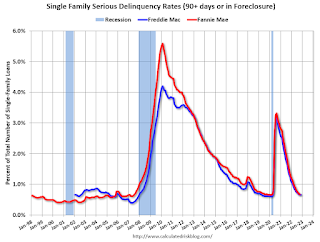
Mortgages in forbearance are being counted as delinquent in this monthly report but are not reported to the credit bureaus.
Realtor.com Reports Weekly Active Inventory Up 58% YoY; New Listings Down 17% YoY
by Calculated Risk on 12/22/2022 04:43:00 PM
Realtor.com has monthly and weekly data on the existing home market. Here is their weekly report released today from Economist Jiayi Xu: Weekly Housing Trends View — Data Week Ending Dec 17, 2022. Note: They have data on list prices, new listings and more, but this focus is on inventory.
• Active inventory growth held steady with for-sale homes up 58% above one year ago. Inventory growth continues to climb higher this week after its first pause in early December.
...
• New listings–a measure of sellers putting homes up for sale–were again down, this week by 17% from one year ago
 Here is a graph of the year-over-year change in inventory according to realtor.com.
Here is a graph of the year-over-year change in inventory according to realtor.com. Note the rapid increase in the YoY change earlier this year, from down 30% at the beginning of the year, to up 29% YoY at the beginning of July.
Vehicle Sales Forecast: "Sales to Weaken Again in December"
by Calculated Risk on 12/22/2022 02:22:00 PM
From WardsAuto: U.S. Light-Vehicle Sales to Weaken Again in December; Inventory Set to Rise (pay content). Brief excerpt:
If Winter Storm Elliott is as bad as predicted, it will create another headwind to December deliveries on top of inventory-related issues, fear of recession and rising prices and interest rates. Conversely, because the bad weather is hitting broad swaths of the U.S. at a time when most vehicle assembly plants will be closed anyway for the holiday season, production losses should be minimal and end-of-month inventory will not significantly suffer because of it.
 Click on graph for larger image.
Click on graph for larger image.This graph shows actual sales from the BEA (Blue), and Wards forecast for December (Red).
The Wards forecast of 13.0 million SAAR, would be down 8% from last month, but up 2% from a year ago (sales weakened in the second half of 2021, due to supply chain issues).
Lawler: Update on Rent Trends
by Calculated Risk on 12/22/2022 11:12:00 AM
Today, in the CalculatedRisk Real Estate Newsletter: Lawler: Update on Rent Trends
Excerpt:
From housing economist Tom Lawler:There is much more in the article. You can subscribe at https://calculatedrisk.substack.com/ Please subscribe!
Recently released data from various private entities that track US rent trends indicate that US rent growth has weakened considerably this Fall, and several measures suggest that rents have fallen by more than the seasonal norm over the last few months.
Here is a table showing monthly % changes in the Apartment List Rent Index (ALRI, not smoothed), the Zillow Observed Rent Index (ZORI, smoothed via 3-month moving average), and the CoreLogic Single Family Rent Index (CLSFRI, smoothed via 3-month moving average.) I’ve included the ALRI on a 3-month moving average basis to be comparable to the other two indices.
...
These rent indices show not only has US rent growth slowed sharply, but that rents have actually begun to fall this Fall, and by more than the seasonal norm.
Q3 GDP Growth Revised Up to 3.2% Annual Rate
by Calculated Risk on 12/22/2022 08:39:00 AM
From the BEA: Gross Domestic Product (Third Estimate), GDP by Industry, and Corporate Profits (Revised), Third Quarter 2022
Real gross domestic product (GDP) increased at an annual rate of 3.2 percent in the third quarter of 2022, according to the "third" estimate released by the Bureau of Economic Analysis. In the second quarter, real GDP decreased 0.6 percent.Here is a Comparison of Third and Second Estimates. PCE growth was revised up from 1.7% to 2.3%. Residential investment was revised down from -26.8% to -27.1%.
The "third" estimate of GDP released today is based on more complete source data than were available for the "second" estimate issued last month. In the second estimate, the increase in real GDP was 2.9 percent. The updated estimates primarily reflected upward revisions to consumer spending and nonresidential fixed investment that were partly offset by a downward revision to private inventory investment. For more information, refer to "Updates to GDP."
...
Real gross domestic income (GDI) increased 0.8 percent in the third quarter, an upward revision of 0.5 percentage point from the previous estimate. The average of real GDP and real GDI, a supplemental measure of U.S. economic activity that equally weights GDP and GDI, increased 2.0 percent in the third quarter, an upward revision of 0.4 percentage point.
emphasis added
Weekly Initial Unemployment Claims increase to 216,000
by Calculated Risk on 12/22/2022 08:33:00 AM
The DOL reported:
In the week ending December 17, the advance figure for seasonally adjusted initial claims was 216,000, an increase of 2,000 from the previous week's revised level. The previous week's level was revised up by 3,000 from 211,000 to 214,000. The 4-week moving average was 221,750, a decrease of 6,250 from the previous week's revised average. The previous week's average was revised up by 750 from 227,250 to 228,000.The following graph shows the 4-week moving average of weekly claims since 1971.
emphasis added
 Click on graph for larger image.
Click on graph for larger image.The dashed line on the graph is the current 4-week average. The four-week average of weekly unemployment claims decreased to 221,750.
The previous week was revised up.
Weekly claims were lower than the consensus forecast.
Black Knight: Mortgage Delinquency Rate Increased in November; Prepayments at Record Low
by Calculated Risk on 12/22/2022 07:00:00 AM
From Black Knight: Black Knight’s First Look: Prepayments Hit Third Consecutive Record Low in November, While Mortgage Delinquencies Top 3.0% and Foreclosure Starts Bounce 19%
• Prepayment activity in November dropped 15.6% to a single month mortality (SMM) rate of 0.40% – once again marking the lowest rate on record since before 2000 when Black Knight started reporting the metricAccording to Black Knight's First Look report, the percent of loans delinquent increased 3.5% in November compared to October and decreased 16% year-over-year.
• The national delinquency rate rose another 3.5% in November to 3.01%, up 10 basis points since October, driven by a 31K (+3.9%) increase in 30-day delinquencies and a 25K (+11%) rise in 60-day delinquencies
• The delinquency rate in Florida rose another 18 basis points in the month to 3.60% as the impact of Hurricane Ian on homeowners’ ability to make mortgage payments continues
• Improvement among seriously past-due loans continues to stagnate, with the population of 90-day delinquencies ticking down -0.2% from the month prior
• Foreclosure starts rose again (+19%) on the heels of October’s increase, but the month’s 23.4K starts are still below the recent high seen in June 2022 and remain 30% below pre-pandemic levels
• Foreclosure was started on 4.3% of serious delinquencies in November, up 7 basis points from October but still 44% less than the rate seen in the years leading up to the pandemic
• Active foreclosure inventory rose 5.3%, though 2022 volumes remain subdued after the record lows of 2021 due to widespread moratoriums and forbearance protections
emphasis added
Black Knight reported the U.S. mortgage delinquency rate (loans 30 or more days past due, but not in foreclosure) was 3.01% in November, up from 2.91% in October.
The percent of loans in the foreclosure process increased in November to 0.37%, from 0.35% in October.
The number of delinquent properties, but not in foreclosure, is down 294,000 properties year-over-year, and the number of properties in the foreclosure process is up 64,000 properties year-over-year.
| Black Knight: Percent Loans Delinquent and in Foreclosure Process | ||||
|---|---|---|---|---|
| Nov 2022 | Oct 2022 | Nov 2021 | Nov 2020 | |
| Delinquent | 3.01% | 2.91% | 3.59% | 6.33% |
| In Foreclosure | 0.37% | 0.35% | 0.25% | 0.33% |
| Number of properties: | ||||
| Number of properties that are delinquent, but not in foreclosure: | 1,612,000 | 1,557,000 | 1,906,000 | 3,381,000 |
| Number of properties in foreclosure pre-sale inventory: | 196,000 | 186,000 | 132,000 | 176,000 |
| Total Properties | 1,808,000 | 1,743,000 | 2,039,000 | 3,557,000 |
Wednesday, December 21, 2022
Thursday: Unemployment Claims, Q3 GDP (Third Estimate)
by Calculated Risk on 12/21/2022 08:31:00 PM
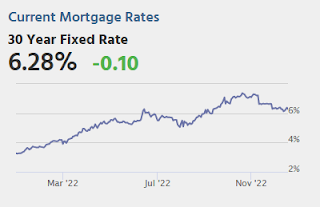
Thursday:
• At 8:30 AM, The initial weekly unemployment claims report will be released. The consensus is for 225 thousand initial claims, up from 211 thousand last week.
• Also at 8:30 AM, Gross Domestic Product, 3rd quarter 2022 (Third estimate). The consensus is for real GDP at 2.9% annualized, unchanged from the second estimate of 2.9%.
• Also at 8:30 AM, Chicago Fed National Activity Index for November. This is a composite index of other data.
• At 11:00 AM, the Kansas City Fed manufacturing survey for December.
The Normal Seasonal Pattern for Median House Prices
by Calculated Risk on 12/21/2022 12:39:00 PM
Earlier, in the CalculatedRisk Real Estate Newsletter on Existing-Home Sales for November, I mentioned that the median price was down more than normal seasonally.

Seasonally prices typically peak in June (closed sales for contracts signed mostly in April and May).
And seasonally prices bottom in January (contracts signed in November and December). I've included the decline from the peak for November for each year to compare to this year.
Existing-Home Sales Decreased to 4.09 million SAAR in November; Median Prices Down 10.4% from Peak in June 2022
by Calculated Risk on 12/21/2022 10:48:00 AM
Today, in the CalculatedRisk Real Estate Newsletter: NAR: Existing-Home Sales Decreased to 4.09 million SAAR in November
Excerpt:
On prices, the NAR reported:There is much more in the article. You can subscribe at https://calculatedrisk.substack.com/ Please subscribe!The median existing-home price for all housing types in November was $370,700, an increase of 3.5% from November 2021 ($358,200), as prices rose in all regions. This marks 129 consecutive months of year-over-year increases, the longest-running streak on record.Median prices are distorted by the mix (repeat sales indexes like Case-Shiller and FHFA are probably better for measuring prices).
The YoY change in the median price peaked at 25.2% in May 2021 and has now slowed to 3.5%. The YoY increase in November was the lowest since June 2020. Note that the median price usually starts falling seasonally in July, so the 2.1% decline in November in the median price was partially seasonal, however the 10.4% decline over the last five months has been much larger than the usual seasonal decline.
It is likely the median price will be down year-over-year in a few months - and Case-Shiller will follow.
NAR: Existing-Home Sales Decreased to 4.09 million SAAR in November
by Calculated Risk on 12/21/2022 10:14:00 AM
From the NAR: Existing-Home Sales Dipped 7.7% in November
Existing-home sales declined for the tenth month in a row in November, according to the National Association of REALTORS®. All four major U.S. regions recorded month-over-month and year-over-year declines.
Total existing-home sales – completed transactions that include single-family homes, townhomes, condominiums and co-ops – waned 7.7% from October to a seasonally adjusted annual rate of 4.09 million in November. Year-over-year, sales dwindled by 35.4% (down from 6.33 million in November 2021).
...
Total housing inventory registered at the end of November was 1.14 million units, which was down 6.6% from October, but up 2.7% from one year ago (1.11 million). Unsold inventory sits at a 3.3-month supply at the current sales pace, which was identical to October, but up from 2.1 months in November 2021.
emphasis added
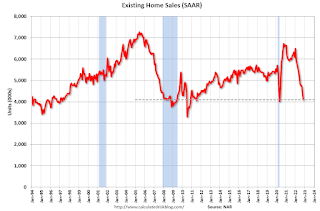 Click on graph for larger image.
Click on graph for larger image.This graph shows existing home sales, on a Seasonally Adjusted Annual Rate (SAAR) basis since 1993.
Sales in November (4.09 million SAAR) were down 7.7% from the previous month and were 35.4% below the November 2021 sales rate.
The second graph shows nationwide inventory for existing homes.
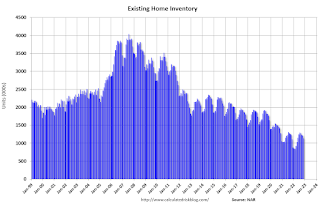 According to the NAR, inventory decreased to 1.14 million in November from 1.22 million in October.
According to the NAR, inventory decreased to 1.14 million in November from 1.22 million in October.The last graph shows the year-over-year (YoY) change in reported existing home inventory and months-of-supply. Since inventory is not seasonally adjusted, it really helps to look at the YoY change. Note: Months-of-supply is based on the seasonally adjusted sales and not seasonally adjusted inventory.
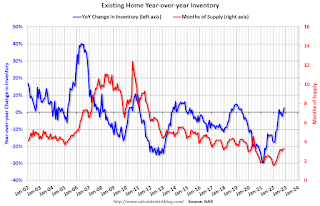 Inventory was up 2.7% year-over-year (blue) in November compared to November 2021.
Inventory was up 2.7% year-over-year (blue) in November compared to November 2021. Months of supply (red) was unchanged at 3.3 months in November from 3.3 months in October.
This was below the consensus forecast. I'll have more later.
MBA: Mortgage Applications Increase in Latest Weekly Survey
by Calculated Risk on 12/21/2022 07:00:00 AM
From the MBA: Mortgage Applications Increase in Latest MBA Weekly Survey
— Mortgage applications increased 0.9 percent from one week earlier, according to data from the Mortgage Bankers Association’s (MBA) Weekly Mortgage Applications Survey for the week ending December 16, 2022.
... The Refinance Index increased 6 percent from the previous week and was 85 percent lower than the same week one year ago. The seasonally adjusted Purchase Index decreased 0.1 percent from one week earlier. The unadjusted Purchase Index decreased 3 percent compared with the previous week and was 36 percent lower than the same week one year ago.
“The Federal Reserve raised its short-term rate target last week, but longer-term rates, including mortgage rates, declined for the week, with the 30-year conforming rate reaching 6.34 percent – its lowest level since September,” said Mike Fratantoni, MBA’s SVP and Chief Economist. “Refinance application volume increased slightly in response but was still about 85 percent below year-ago levels. This is a particularly slow time of year for homebuying, so it is not surprising that purchase applications did not move much in response to lower mortgage rates.”
Added Fratantoni: “The latest data on the housing market show that homebuilders are pulling back the pace of new construction in response to low levels of traffic, and we expect this weakness in demand will persist in 2023, as the U.S. is likely to enter a recession. However, if mortgage rates continue to trend down, as we are forecasting, more buyers are likely to return to the market later in the year, as affordability improves with both lower rates and slower home-price growth.”
...
The average contract interest rate for 30-year fixed-rate mortgages with conforming loan balances ($647,200 or less) decreased to 6.34 percent from 6.42 percent, with points decreasing to 0.59 from 0.64 (including the origination fee) for 80 percent loan-to-value ratio (LTV) loans.
emphasis added
 Click on graph for larger image.
Click on graph for larger image.The first graph shows the refinance index since 1990.
Note: Red is a four-week average (blue is weekly).
Tuesday, December 20, 2022
Wednesday: Existing Home Sales
by Calculated Risk on 12/20/2022 09:00:00 PM

Wednesday:
• At 7:00 AM ET, The Mortgage Bankers Association (MBA) will release the results for the mortgage purchase applications index.
• 10:00 AM, Existing Home Sales for November from the National Association of Realtors (NAR). The consensus is for 4.20 million SAAR, down from 4.43 million
CoreLogic: "Annual Single-Family Rent Price Growth Falls to Single Digits in October"
by Calculated Risk on 12/20/2022 11:39:00 AM
From CoreLogic: Annual US Single-Family Rent Price Growth Falls to Single Digits in October, CoreLogic Reports
U.S. rental price growth slowed for the sixth straight month on an annual basis in October to 8.8%, the lowest rate of appreciation in more than a year but still three times higher than the pre-pandemic level. Despite the continued cooling, a shortage of available properties is keeping costs elevated, a trend that is partially fueling year-over-year gains in the lower-priced tier. Miami led the nation for rent growth for the 15th consecutive month at 16.3%, but gains there have slowed dramatically since the spring when they hit 40.8%.
“Single-family rents decreased again on a monthly basis in October but were still up year over year,” said Molly Boesel, principal economist at CoreLogic. “While rents typically experience a seasonal decline in October, this year’s decrease was larger than average and could point to prices slowing more sharply than expected in the coming months.”
emphasis added
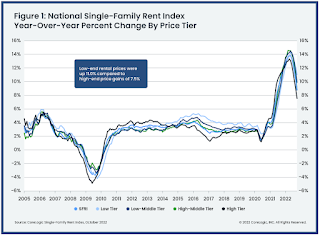 Click on graph for larger image.
Click on graph for larger image.This graph from CoreLogic shows the year-over-year change in rents for several price tiers.
This index was reported to be up 10.2% YoY in September - and is slowing quickly.
November Housing Starts: Record Number of Housing Units Under Construction
by Calculated Risk on 12/20/2022 09:27:00 AM
Today, in the CalculatedRisk Real Estate Newsletter: November Housing Starts: Record Number of Housing Units Under Construction
Excerpt:
Possibly Important: Note the sharp decline in multi-family permits in November. This has been averaging close to 650,000 SAAR over the last 8 months and declined to 509,000 in November from 620,000 in October. This is a possible signal that the expected decline in multi-family starts will happen soon (although permits aren’t a perfect leading indicator for starts).There is much more in the post. You can subscribe at https://calculatedrisk.substack.com/
...
The fourth graph shows housing starts under construction, Seasonally Adjusted (SA).
Red is single family units. Currently there are 777 thousand single family units (red) under construction (SA). This is below the previous seven months, and 51 thousand below the recent peak in April and May. Single family units under construction have peaked since single family starts are now declining. The reason there are so many homes under construction is probably due to supply constraints.
Blue is for 2+ units. Currently there are 932 thousand multi-family units under construction. This is the highest level since December 1973! For multi-family, construction delays are probably also a factor. The completion of these units should help with rent pressure.
Combined, there are 1.709 million units under construction. This ties last month as the all-time record number of units under construction.
...
Multi-family starts will likely slow soon due to a combination of less rent growth and higher interest rates. We are already seeing a slowdown in design for multi-family.
Housing Starts Decreased to 1.427 million Annual Rate in November
by Calculated Risk on 12/20/2022 08:36:00 AM
From the Census Bureau: Permits, Starts and Completions
Housing Starts:
Privately‐owned housing starts in November were at a seasonally adjusted annual rate of 1,427,000. This is 0.5 percent below the revised October estimate of 1,434,000 and is 16.4 percent below the November 2021 rate of 1,706,000. Single‐family housing starts in November were at a rate of 828,000; this is 4.1 percent below the revised October figure of 863,000. The November rate for units in buildings with five units or more was 584,000.
Building Permits:
Privately‐owned housing units authorized by building permits in November were at a seasonally adjusted annual rate of 1,342,000. This is 11.2 percent below the revised October rate of 1,512,000 and is 22.4 percent below the November 2021 rate of 1,729,000. Single‐family authorizations in November were at a rate of 781,000; this is 7.1 percent below the revised October figure of 841,000. Authorizations of units in buildings with five units or more were at a rate of 509,000 in November.
emphasis added
 Click on graph for larger image.
Click on graph for larger image.The first graph shows single and multi-family housing starts for the last several years.
Multi-family starts (blue, 2+ units) increased in November compared to October. Multi-family starts were up 23.3% year-over-year in November.
Single-family starts (red) decreased in November and were down 32.1% year-over-year.
 The second graph shows single and multi-family housing starts since 1968.
The second graph shows single and multi-family housing starts since 1968. This shows the huge collapse following the housing bubble, and then the eventual recovery.
Total housing starts in November were above expectations, however, starts in September and October were revised down, combined.
I'll have more later …

